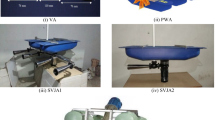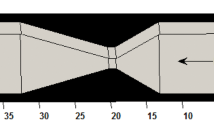Abstract
Dissolved oxygen (DO) is a vital nutrient for the health of water bodies such as streams, rivers, and ponds, as it is used in respiration and other biological activity of aquatic animals. Natural replenishment of oxygen through photosynthesis in aquatic bodies is insufficient to meet the high requirements for an intensive aquaculture system, which compels farmers to use aeration systems to supplement the natural process of DO accumulation. When the demand for oxygen (KgO2/h) is lower, venturi aerators may be more effective than other aerators. The venturi device is an aeration system which is highly efficient in providing an adequate supply of DO, and is flexible in nature and easy to operate. To evaluate the efficacy of air entrainment holes on the throat of a venturi, aeration experiments were conducted for different throat lengths (Lt) of 20, 40, 60, 80 and 100 mm, varying the number of air holes according to throat length while maintaining a constant air hole diameter of 2 mm. Aeration efficiency was found to increase with an increasing number of air holes. The highest oxygen transfer coefficients for throat lengths of 20, 40, 60, 80 and 100 mm were 0.497 h−1, 0.756 h−1, 1.045 h−1, 0.627 h−1 and 1.072 h−1, respectively, with the maximum number of air holes (NH). The maximum standard aeration efficiency was found to be 1.25 × 10−2 kgO2/kWh for a throat length of 100 mm with the maximum number of air holes (NH17). Hence, the physical properties of throat length, number of air holes, and distribution of air holes on the throat section were proven to be key factors controlling the performance of the venturi aeration system.






Similar content being viewed by others
References
ASCE (1993) Standard- Measuraments of oxygen transfer in clean water. ANSI/ASCE2-91, American Socienty of Civil Engineers, New York
Bagatur T, Baylar A (2006) Experimental studies on air entrainment and oxygen content downstream of sharp-crested weirs. Turkey Water Environ J 20(4):210–216
Bagatur T, Sekerdag N (2003) Air entrainment characteristics in plunging water jet system using rectangular nozzles with rounded ends. Water SA 29(1):35–38
Bagatur T, Baylar A, Sekerdag N (2002) The effect of nozzle type on air entrainment by plunging water jets. Water Qual Res J Can 37(3):599–612
Bando Y, Kuraishi M, Nishimura M, Takeshita I (1990) The characteristics of a bubble column with a gas suction-type, simultaneous gas–liquid injection-nozzle. Int J Chem Eng 30:729–737
Baylar A (2003) An investigation on the use of venturi weirs as an aerator. Water Qual Res J Can 38(4):753–767
Baylar A, Emiroglu ME (2003) Air entrainment and oxygen transfer in a venturi. Proc Inst Civ Eng Water Marit Eng 156:249–255
Baylar A, Emiroglu M (2004) An experimental study of air entrainment and oxygen transfer at a water jet from a nozzle with air holes. Water Environ Res 76:231–237
Baylar A, Ozkan F (2006) Applications of Venturi principle to water aeration systems. Environ Fluid Mech 6:341–357
Baylar A, Ozkan F, Ozturk M (2005) Influence of venturi cone angles on jet aeration systems. Proc Inst Civ Eng Water Manag 15(8):9–16
Baylar A, Ozkan F, Unsal M (2009) Effect of air inlet hole diameter of venturi tube on air injection rate. KSCE J Civ Eng 14(4):489–492
Baylar A, Ozkan F, Unsal M (2010) Effect of air inlet hole diameter of venturi tube on air injection rate. J Civ Eng 14:489. https://doi.org/10.1007/s12205-010-0489-6
Boyd CE, Ahmad T (1987) Evaluation of aerators for channel catfish farming. Bulletin 584, Alabama Agricultural Experiment Station, Auburn University, Alabama, 52
Danckwerst PV (1951) Significance of liquid film coefficient in gas absorption. Ind Eng Chem 1460
Dobbins WE (1956) The nature of the oxygen transfer coefficient in aeration systems. In: Biological Treatment of Sewage and Industrial Wastes. Rheinhold Publishing Corp., New York, pp 141–183
Eckenfelder WW, Ford DL (1970) Water pollution control. Pemberton Press, Jenkins Publication, Austin Taxes
Emiroglu ME, Baylar A (2003) Study of the influence of air holes along length of convergent-divergent passage of a venturi device on aeration. J Hydraul Res 41(5):513–520
Ghomi MR, Sohrabnejad M, Ovissipour MR (2009) An experimental study of nozzle diameters, aeration depths and angles on standard aeration efficiency (SAE) in a venturi aerator. Water Pract Technol 4(3):1–8
Havelka P, Linek V, Sinkule J, Zahradnik J, Fialova M (1997) Effect of the ejector configuration on the gas suction rate and gas hold-up in ejector loop reactors. Chem Eng Sci 52:1701–1713
Higbie R (1935) The rate of absorption of a pure gas into a still liquid during short periods of exposure, trans. AICHE 31:365–389
Kandakure MT, Gaikar VG, Patwardhan AW (2005) Hydrodynamic aspects of ejectors. Chem Eng Sci 60:6391–6402
Khound A, Yadav A, Kumar A, Sarkar S (2017) Influence of throat length and flow parameters on a venturi as an aerator. Int J Agric Environ Biotechnol 10(6):717–723
Lewis WK, Whitman WG (1924) Principles of gas absorption. Ind Eng Chem 16(12):215–1220
Metcalf & Eddy, Inc. (2003) Wastewater engineering: treatment and reuse. McGraw-Hill, Boston
Ozkan F, Baylar A, Tugal M (2006) The performance of two phase flow systems in pond aeration. Int J Sci Technol 1:65–74
Rathinakumar V, Dhinakaran G, Suribabu CR (2014) Assessment of aeration capacity of stepped cascade system for selected geometry. Int J Chem Technol Res 6(1):254–262
Wang X, Zhang Y (1999) Development of a critical airflow venturi for air sampling. J Agric Eng Res 73:257–264
Yin Z, Feng Y, Wang Y, Gao C, Ma N (2018) 3-D numerical investigation on oxygen transfer in a horizontal venturi flow with two holes. Water 10(2):1–13
Zhang JX (2017) Analysis on the effect of venturi tube structural parameters on fluid flow. AIP Adv 7:1–9
Author information
Authors and Affiliations
Corresponding author
Additional information
Publisher’s note
Springer Nature remains neutral with regard to jurisdictional claims in published maps and institutional affiliations.
Rights and permissions
About this article
Cite this article
Yadav, A., Kumar, A. & Sarkar, S. An experimental study to evaluate the efficacy of air entrainment holes on the throat of a venturi aeration system. Aquacult Int 28, 1057–1068 (2020). https://doi.org/10.1007/s10499-020-00511-6
Received:
Accepted:
Published:
Issue Date:
DOI: https://doi.org/10.1007/s10499-020-00511-6




